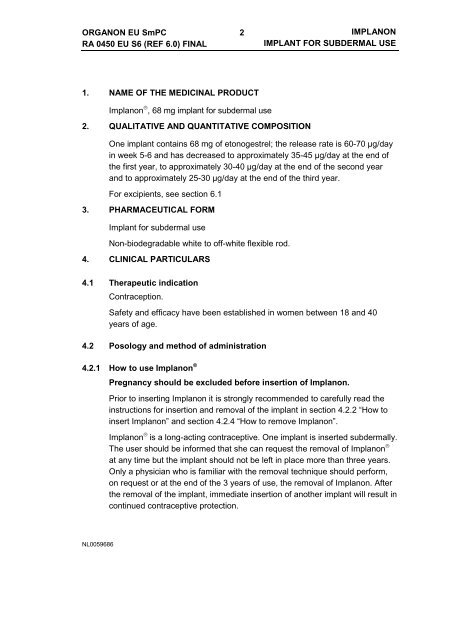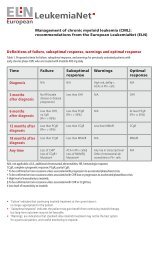IMPLANON IMPLANT FOR SUBDERMAL USE ... - epgonline.org
IMPLANON IMPLANT FOR SUBDERMAL USE ... - epgonline.org
IMPLANON IMPLANT FOR SUBDERMAL USE ... - epgonline.org
You also want an ePaper? Increase the reach of your titles
YUMPU automatically turns print PDFs into web optimized ePapers that Google loves.
ORGANON EU SmPC<br />
RA 0450 EU S6 (REF 6.0) FINAL<br />
2<br />
<strong>IMPLANON</strong><br />
<strong>IMPLANT</strong> <strong>FOR</strong> <strong>SUBDERMAL</strong> <strong>USE</strong><br />
1. NAME OF THE MEDICINAL PRODUCT<br />
Implanon ® , 68 mg implant for subdermal use<br />
2. QUALITATIVE AND QUANTITATIVE COMPOSITION<br />
One implant contains 68 mg of etonogestrel; the release rate is 60-70 µg/day<br />
in week 5-6 and has decreased to approximately 35-45 µg/day at the end of<br />
the first year, to approximately 30-40 µg/day at the end of the second year<br />
and to approximately 25-30 µg/day at the end of the third year.<br />
For excipients, see section 6.1<br />
3. PHARMACEUTICAL <strong>FOR</strong>M<br />
Implant for subdermal use<br />
Non-biodegradable white to off-white flexible rod.<br />
4. CLINICAL PARTICULARS<br />
4.1 Therapeutic indication<br />
Contraception.<br />
Safety and efficacy have been established in women between 18 and 40<br />
years of age.<br />
4.2 Posology and method of administration<br />
4.2.1 How to use Implanon ®<br />
Pregnancy should be excluded before insertion of Implanon.<br />
Prior to inserting Implanon it is strongly recommended to carefully read the<br />
instructions for insertion and removal of the implant in section 4.2.2 “How to<br />
insert Implanon” and section 4.2.4 “How to remove Implanon”.<br />
Implanon ® is a long-acting contraceptive. One implant is inserted subdermally.<br />
The user should be informed that she can request the removal of Implanon ®<br />
at any time but the implant should not be left in place more than three years.<br />
Only a physician who is familiar with the removal technique should perform,<br />
on request or at the end of the 3 years of use, the removal of Implanon. After<br />
the removal of the implant, immediate insertion of another implant will result in<br />
continued contraceptive protection.<br />
NL0059686
ORGANON EU SmPC<br />
RA 0450 EU S6 (REF 6.0) FINAL<br />
3<br />
<strong>IMPLANON</strong><br />
<strong>IMPLANT</strong> <strong>FOR</strong> <strong>SUBDERMAL</strong> <strong>USE</strong><br />
To ensure uncomplicated removal it is necessary that Implanon ® is inserted<br />
correctly, directly under the skin. The risk of complications is small if the<br />
provided instructions are followed.<br />
Some cases have been reported in which the implant was not inserted<br />
correctly or was not inserted at all. Incidentally, this has resulted in an<br />
unintended pregnancy. The occurrence of such incidents can be<br />
minimized when the instructions for insertion (section 4.2.2 “How to<br />
insert Implanon”) are strictly followed. The presence of the implant<br />
should be verified by palpation directly after insertion. In case the<br />
implant cannot be palpated or when the presence of the implant is<br />
doubtful, other methods must be applied to confirm its presence (see<br />
paragraph 4.2.2 How to insert Implanon). Until the presence of Implanon<br />
has been verified a contraceptive barrier method must be used.<br />
It is strongly recommended that physicians, prior to practicing the insertion of<br />
Implanon, participate in training sessions <strong>org</strong>anized by Organon. Physicians<br />
who have little experience with subdermal insertion are advised to acquire the<br />
correct technique under supervision of a more experienced colleague.<br />
Additional information and more detailed instructions concerning the insertion<br />
and removal of Implanon ® will be sent on request free of charge (Local<br />
Organon affiliate, telephone: xxxxxx).<br />
The Implanon package contains a <strong>USE</strong>R CARD intended for the user, and an<br />
adhesive label intended for the physician’s user record. The <strong>USE</strong>R CARD<br />
records the batch number of the provided implant, and helps to memorize the<br />
date of insertion, the arm of insertion, the name of the doctor and / or the<br />
hospital, and the intended day of removal. The adhesive label records the<br />
batch number and date of insertion.<br />
4.2.2 How to insert Implanon ®<br />
• Insertion of Implanon ® should be performed under aseptic conditions, and only by a physician who<br />
is familiar with the procedure.<br />
• Insertion of Implanon is performed with the specially designed applicator. The use of this applicator<br />
differs substantially from that of a classical syringe. A drawing of a dismantled applicator and its<br />
individual components (e.g. cannula, obturator and needle with double-angled bevel) is shown in<br />
this leaflet to clarify their specific functions.<br />
• The procedure used for insertion of Implanon is opposite to giving an injection. When inserting<br />
Implanon the obturator must remain fixed while the cannula (needle) is retracted from the arm. For<br />
normal injections the plunger is pushed and the body of the syringe remains fixed.<br />
NL0059686
ORGANON EU SmPC<br />
RA 0450 EU S6 (REF 6.0) FINAL<br />
4<br />
<strong>IMPLANON</strong><br />
<strong>IMPLANT</strong> <strong>FOR</strong> <strong>SUBDERMAL</strong> <strong>USE</strong><br />
• Allow the subject to lie on her back with her non-dominant arm (the arm, which the woman does not<br />
use for writing) turned outwards and bent at the elbow.<br />
• Implanon ® should be inserted at the inner side of the upper arm (non-dominant arm) about 6-8 cm<br />
above the elbow crease in the groove between the biceps and the triceps (sulcus bicipitalis<br />
medialis).<br />
• Mark the insertion site.<br />
• Clean the insertion site with a disinfectant.<br />
• Anaesthetize with an anaesthetic spray, or with 2 ml of lidocaine (1%) applied just under the skin<br />
along the ‘insertion canal’.<br />
• Remove the sterile disposable applicator carrying Implanon ® from its blister and remove the needle<br />
shield.<br />
• Always hold the applicator in the upward position (i.e. with the needle pointed upwards) until the<br />
time of insertion. This to prevent the implant from dropping out.<br />
• Visually verify the presence of the implant inside the metal part of the cannula (the needle). The<br />
implant can be seen as a white tip inside the needle. If the implant protrudes from the needle, return<br />
it to its original position by tapping against the plastic part of the cannula. Keep the needle and the<br />
implant sterile. If contamination occurs, a new package with a new sterile applicator must be used.<br />
• Stretch the skin around the insertion site with thumb and index finger (Figure 1).<br />
• Insert only the tip of the needle, slightly angled (~ 20°) (Figure 2).<br />
NL0059686
ORGANON EU SmPC<br />
RA 0450 EU S6 (REF 6.0) FINAL<br />
5<br />
<strong>IMPLANON</strong><br />
<strong>IMPLANT</strong> <strong>FOR</strong> <strong>SUBDERMAL</strong> <strong>USE</strong><br />
• Release the skin.<br />
• Lower the applicator to a horizontal position (Figure 3).<br />
• Lift the skin with the tip of the needle, but keep the needle in the subdermal connective tissue<br />
(Figure 4).<br />
• Gently insert, while lifting the skin, the needle to its full length without using force.<br />
• Keep the applicator parallel to the surface of the skin.<br />
• When the implant is placed too deeply the removal can be hampered later on.<br />
• Break the seal of the applicator (Figure 5).<br />
• Turn the obturator 90° (Figure 6).<br />
• Fix the obturator with one hand against the arm and with the other hand slowly retract the cannula<br />
(needle) out of the arm (Figure 7).<br />
• Never push against the obturator.<br />
• Check the needle for the absence of the implant. After retraction of the cannula, the grooved tip of<br />
the obturator should be visible (Figure 8).<br />
• Always verify the presence of the implant by palpation.<br />
• In case the implant can not be palpated or when the presence of the implant is doubtful, other<br />
methods must be applied to confirm its presence. Suitable methods to locate the implant are first of<br />
all ultrasound (USS) and secondly magnetic resonance imaging (MRI). Prior to the application of<br />
NL0059686
ORGANON EU SmPC<br />
RA 0450 EU S6 (REF 6.0) FINAL<br />
6<br />
<strong>IMPLANON</strong><br />
<strong>IMPLANT</strong> <strong>FOR</strong> <strong>SUBDERMAL</strong> <strong>USE</strong><br />
USS or MRI for the localization of Implanon it is recommended to consult Organon for instructions.<br />
In case these imaging methods fail, it is advised to verify the presence of the implant by measuring<br />
the etonogestrel level in a blood sample of the subject. In this case Organon will also provide the<br />
appropriate procedure.<br />
• Until the presence of Implanon has been confirmed a contraceptive barrier method must be<br />
used.<br />
• Apply sterile gauze with a pressure bandage to prevent bruising.<br />
• Fill out the User Card and hand it over to the subject to facilitate removal of the implant later on.<br />
• The applicator is for single use only and must be adequately disposed of, in accordance with local<br />
regulations for the handling of biohazardous waste.<br />
4.2.3 When to insert Implanon ®<br />
No preceding hormonal contraceptive use<br />
Implanon ® should be inserted between Day 1-5, but at the latest on Day 5 of<br />
the woman’s natural cycle (Day 1 is the first day of her menstrual bleeding).<br />
Changing from a combined oral contraceptive (COC)<br />
Implanon should be inserted preferably on the day after the last active tablet<br />
(the last tablet containing the active substances) of her previous COC, but at<br />
the latest on the day following the usual tablet-free interval or following the<br />
last placebo tablet of her previous COC.<br />
Changing from a progestagen-only-method (minipill, injectable, a different<br />
implant)<br />
Implanon ® may be inserted any day when the woman is switching from a<br />
minipill (from another implant on the day of its removal, from an injectable<br />
when the next injection would be due).<br />
Following first-trimester abortion<br />
Implanon ® should be inserted immediately.<br />
Following childbirth or a second-trimester abortion<br />
For breastfeeding women see ‘Use during pregnancy and lactation’<br />
Implanon ® should be inserted on day 21-28 after delivery or second-trimester<br />
abortion. When the implant is inserted later, the woman should be advised to<br />
additionally use a barrier method on the first 7 days after the insertion.<br />
However, if intercourse has already occurred, pregnancy should be excluded<br />
NL0059686
ORGANON EU SmPC<br />
RA 0450 EU S6 (REF 6.0) FINAL<br />
7<br />
<strong>IMPLANON</strong><br />
<strong>IMPLANT</strong> <strong>FOR</strong> <strong>SUBDERMAL</strong> <strong>USE</strong><br />
or the woman’s first natural period should be awaited before the actual<br />
insertion of the implant.<br />
4.2.4 How to remove Implanon ®<br />
• Removal of Implanon ® should only be performed by a physician who is familiar with the removal<br />
technique.<br />
• The precise location of the implant is indicated on the<br />
<strong>USE</strong>R CARD<br />
• Locate the implant by palpation and mark the distal<br />
end.<br />
In case that Implanon can not be palpated it is strongly<br />
advised to locate the implant by either ultrasound (USS)<br />
or magnetic resonance imaging (MRI). Prior to the<br />
application of USS and MRI for the localization of<br />
Implanon it is recommended to consult Organon for the<br />
proper instructions (Figure a).<br />
• A non-palpable implant should always first be localized<br />
by USS (or MRI) and subsequently be removed under<br />
the guidance of USS.<br />
• Wash the area and apply a disinfectant<br />
• Anaesthetize the arm with 0.5-1 ml lidocaine (1%) at<br />
the site of incision, which is just below the distal end of<br />
the implant. Note: Apply the anaesthetic under the<br />
implant. Application above the implant makes the skin<br />
swell, which may cause difficulties in locating the<br />
implant (Figure b).<br />
• Make an incision of 2 mm in length in the longitudinal<br />
direction of the arm at the distal end of the implant<br />
(Figure c).<br />
NL0059686
ORGANON EU SmPC<br />
RA 0450 EU S6 (REF 6.0) FINAL<br />
8<br />
<strong>IMPLANON</strong><br />
<strong>IMPLANT</strong> <strong>FOR</strong> <strong>SUBDERMAL</strong> <strong>USE</strong><br />
• Gently push the implant towards the incision until the<br />
tip is visible. Grasp the implant with forceps (preferably<br />
‘mosquito’ forceps) and remove it (Figure d).<br />
• If the implant is encapsulated, an incision into the tissue sheath should be made and the implant<br />
then removed with forceps (Figures e and f).<br />
• If the tip of the implant is not visible, gently insert a forceps into the incision and grasp the implant<br />
(Figures g and h). With a second forceps carefully dissect the tissue around the implant. The implant<br />
can then be removed (Figure i).<br />
• Close the incision with a butterfly closure.<br />
• Apply sterile gauze with a pressure bandage to prevent bruising.<br />
• There have been occasional reports of displacement of the implant; usually this involves minor<br />
movement relative to the original position. This may somewhat complicate removal.<br />
NL0059686
ORGANON EU SmPC<br />
RA 0450 EU S6 (REF 6.0) FINAL<br />
9<br />
<strong>IMPLANON</strong><br />
<strong>IMPLANT</strong> <strong>FOR</strong> <strong>SUBDERMAL</strong> <strong>USE</strong><br />
4.3 Contraindications<br />
• Active venous thromboembolic disorder.<br />
• Progestagen-dependent tumors.<br />
• Presence or history of severe hepatic disease as long as liver function<br />
values have not returned to normal.<br />
• Undiagnosed vaginal bleeding.<br />
• Hypersensitivity to the active substance or to any of the excipients of<br />
Implanon ® .<br />
4.4 Special warnings and special precautions for use<br />
4.4.1 Warnings<br />
If any of the conditions / risk factors mentioned below is present, the benefits<br />
of progestagen use should be weighed against the possible risks for each<br />
individual woman and discussed with the woman before she decides to start<br />
with Implanon ® . In the event of aggravation, exacerbation or first appearance<br />
of any of these conditions, the woman should contact her physician. The<br />
physician should then decide on whether the use of Implanon ® should be<br />
discontinued.<br />
NL0059686<br />
• The risk for breast cancer increases in general with increasing age. During<br />
the use of oral contraceptives (OCs) the risk of having breast cancer<br />
diagnosed is slightly increased. This increased risk disappears gradually<br />
within 10 years after discontinuation of OC use and is not related to the<br />
duration of use, but to the age of the woman when using the OC. The<br />
expected number of cases diagnosed per 10 000 women who use<br />
combined OCs (up to 10 years after stopping) relative to never users over<br />
the same period have been calculated for the respective age groups to<br />
be: 4.5/4 (16-19 years), 17.5/16 (20-24 years), 48.7/44 (25-29 years),<br />
110/100 (30-34 years), 180/160 (35-39 years) and 260/230 (40-44 years).<br />
The risk in users of contraceptive methods, which only contain<br />
progestagens, is possibly of similar magnitude as that associated with<br />
combined OCs. However, for these methods, the evidence is less<br />
conclusive. Compared to the risk of getting breast cancer ever in life, the<br />
increased risk associated with OCs is low. The cases of breast cancer<br />
diagnosed in OC users tend to be less advanced than in those who have<br />
not used OCs. The increased risk observed in OC users may be due to an<br />
earlier diagnosis, biological effects of the OC or a combination of both.<br />
Since a biological effect of hormones cannot be excluded, an individual
ORGANON EU SmPC<br />
RA 0450 EU S6 (REF 6.0) FINAL<br />
10<br />
<strong>IMPLANON</strong><br />
<strong>IMPLANT</strong> <strong>FOR</strong> <strong>SUBDERMAL</strong> <strong>USE</strong><br />
NL0059686<br />
benefit/risk assessment should be made in women with pre-existing<br />
breast cancer and in women in whom breast cancer is diagnosed while<br />
using Implanon ® .<br />
• Epidemiological investigations have associated the use of combined OCs<br />
with an increased incidence of venous thromboembolism (VTE, deep<br />
venous thrombosis and pulmonary embolism). Although the clinical<br />
relevance of this finding for etonogestrel (the biologically active metabolite<br />
of desogestrel) used as a contraceptive in the absence of an estrogenic<br />
component is unknown, Implanon ® should be removed in the event of a<br />
thrombosis. Removal of Implanon ® should also be considered in case of<br />
long-term immobilization due to surgery or illness. Women with a history<br />
of thrombo-embolic disorders should be made aware of the possibility of a<br />
recurrence.<br />
• If a sustained hypertension develops during the use of Implanon ® , or if a<br />
significant increase in blood pressure does not adequately respond to<br />
antihypertensive therapy, the use of Implanon ® should be discontinued.<br />
• When acute or chronic disturbances of liver function occur the woman<br />
should be referred to a specialist for examination and advice.<br />
• The use of progestagen-containing contraceptives may have an effect on<br />
peripheral insulin resistance and glucose tolerance. Therefore, diabetic<br />
women should be carefully monitored during the first months of Implanon ®<br />
use.<br />
• Chloasma may occasionally occur, especially in women with a history of<br />
chloasma gravidarum. Women with a tendency to chloasma should avoid<br />
exposure to the sun or ultraviolet radiation whilst using Implanon ® .<br />
• The contraceptive effect of Implanon is related to the plasma levels of<br />
etonogestrel, which are inversely related to body weight, and decrease<br />
with time after insertion. The clinical experience with Implanon in heavier<br />
women in the third year of use is limited. Therefore it can not be excluded<br />
that the contraceptive effect in these women during the third year of use<br />
may be lower than for women of normal weight. Clinicians may therefore<br />
consider earlier replacement of the implant in heavier women.<br />
• Expulsion may occur if the implant is inserted not according to the<br />
instructions given in section 4.2.2 “How to insert Implanon”.<br />
• With all low-dose hormonal contraceptives, follicular development occurs<br />
and occasionally the follicle may continue to grow beyond the size it would
ORGANON EU SmPC<br />
RA 0450 EU S6 (REF 6.0) FINAL<br />
11<br />
<strong>IMPLANON</strong><br />
<strong>IMPLANT</strong> <strong>FOR</strong> <strong>SUBDERMAL</strong> <strong>USE</strong><br />
attain in a normal cycle. Generally, these enlarged follicles disappear<br />
spontaneously. Often, they are asymptomatic; in some cases they are<br />
associated with mild abdominal pain. They rarely require surgical<br />
intervention.<br />
• The protection with traditional progestagen-only contraceptives against<br />
ectopic pregnancies is not as good as with combined OCs, which has<br />
been associated with the frequent occurrence of ovulations during the use<br />
of these methods. Despite the fact that Implanon ® consistently inhibits<br />
ovulation, ectopic pregnancy should be taken into account in the<br />
differential diagnosis if the woman gets amenorrhea or abdominal pain.<br />
• The following conditions have been reported both during pregnancy and<br />
during sex steroid use, but an association with the use of progestagens has<br />
not been established: jaundice and/or pruritus related to cholestasis;<br />
gallstone formation; porphyria; systemic lupus erythematosus; hemolytic<br />
uraemic syndrome; Sydenham’s chorea; herpes gestationis; otosclerosisrelated<br />
hearing loss.<br />
4.4.2 Medical examination/consultation<br />
Prior to the initiation or reinstitution of Implanon ® a complete medical history<br />
(including family medical history) should be taken and pregnancy should be<br />
excluded. Blood pressure should be measured and a physical examination<br />
should be performed, guided by the contraindications (Section 4.3) and<br />
warnings (Section 4.4.1). It is recommended that the woman returns for a<br />
medical check-up three months after insertion of Implanon ® . During this<br />
check-up, the blood pressure should be measured and an enquiry should be<br />
made after any questions, complaints or the occurrence of undesirable<br />
effects. The frequency and nature of further periodic checks should be<br />
adapted to the individual woman, guided by clinical judgment.<br />
Women should be advised that Implanon ® does not protect against HIV<br />
(AIDS) and other sexually transmitted diseases.<br />
4.4.3 Reduced efficacy<br />
The efficacy of Implanon ® may be reduced when concomitant medication is<br />
used (See ‘Interactions’ (4.5.1)).<br />
NL0059686
ORGANON EU SmPC<br />
RA 0450 EU S6 (REF 6.0) FINAL<br />
12<br />
<strong>IMPLANON</strong><br />
<strong>IMPLANT</strong> <strong>FOR</strong> <strong>SUBDERMAL</strong> <strong>USE</strong><br />
4.4.4 Changes in the vaginal bleeding pattern<br />
During the use of Implanon, vaginal bleeding may become more frequent or<br />
of longer duration in most women. In other women bleeding may become<br />
incidental or be totally absent (approximately in 1 out of 5 women).<br />
Information, counseling and the use of a bleeding diary can improve the<br />
woman’s acceptance of a bleeding pattern. Evaluation of vaginal bleeding<br />
should be done on an ad hoc basis and may include an examination to<br />
exclude gynecological pathology or pregnancy.<br />
4.5 Interaction with other medicinal products and other forms of interaction<br />
4.5.1 Interactions<br />
Interactions between hormonal contraceptives and other medicinal products<br />
may lead to breakthrough bleeding and / or contraceptive failure. No specific<br />
interaction studies have been performed with Implanon. The following<br />
interactions have been reported in the literature (mainly with combined<br />
contraceptives but occasionally also with progestogen-only contraceptives).<br />
Hepatic metabolism: Interactions can occur with medicinal products that<br />
induce microsomal enzymes, specifically cytochrome P450 enzymes, which<br />
can result in increased clearance of sex hormones (e.g., phenytoin,<br />
phenobarbital, primidone, carbamazepine, rifampicin, and possibly also<br />
oxcarbazepine, topiramate, felbamate, ritonavir, nelfinavir, griseofulvin and<br />
the herbal remedy St. Johns wort).<br />
Women on treatment with any of these drugs should temporarily use a barrier<br />
method in addition to Implanon. With microsomal enzyme-inducing drugs, the<br />
barrier method should be used during the time of concomitant drug<br />
administration and for 28 days after their discontinuation.<br />
In women on long-term treatment with hepatic enzyme-inducing drugs, it is<br />
recommended to remove Implanon and to prescribe a non-hormonal method.<br />
Hormonal contraceptives may interfere with the metabolism of other drugs.<br />
Accordingly, plasma and tissue concentrations may be affected (e.g.,<br />
cyclosporin).<br />
Note: The prescribing information of concomitant medications should be<br />
consulted to identify potential interactions<br />
NL0059686
ORGANON EU SmPC<br />
RA 0450 EU S6 (REF 6.0) FINAL<br />
13<br />
<strong>IMPLANON</strong><br />
<strong>IMPLANT</strong> <strong>FOR</strong> <strong>SUBDERMAL</strong> <strong>USE</strong><br />
4.5.2 Laboratory tests<br />
Data obtained with combined OCs have shown that contraceptive steroids<br />
may influence the results of certain laboratory tests, including biochemical<br />
parameters of liver, thyroid, adrenal and renal function, serum levels of<br />
(carrier) proteins, e.g., corticosteroid binding globulin and lipid/lipoprotein<br />
fractions, parameters of carbohydrate metabolism and parameters of<br />
coagulation and fibrinolysis. The changes generally remain within the normal<br />
range. To what extent this also applies to progestagen-only contraceptives is<br />
not known.<br />
4.6 Pregnancy and lactation<br />
Implanon is not indicated during pregnancy. If pregnancy occurs during use of<br />
Implanon, the implant should be removed. Animal studies have shown that<br />
very high doses of progestagenic substances may cause masculinisation of<br />
female fetuses. Extensive epidemiological studies have revealed neither an<br />
increased risk of birth defects in children born to women who used OCs prior to<br />
pregnancy, nor of a teratogenic effect when OCs were inadvertently used<br />
during pregnancy. Although this probably applies to all OCs, it is not clear<br />
whether this is also the case for Implanon ® .<br />
Pharmacovigilance data with various desogestrel-containing combined OCs<br />
(etonogestrel is a metabolite of desogestrel) also do not indicate an increased<br />
risk.<br />
Implanon does not influence the production or the quality (protein, lactose or<br />
fat concentrations) of breast milk. However, small amounts of etonogestrel<br />
are excreted in breast milk. Based on daily milk ingestion of 150 ml/kg, the<br />
mean daily infant etonogestrel dose calculated after one month of<br />
etonogestrel release is approximately 27 ng/kg/day. This corresponds to<br />
approximately 2.2% of the weight-adjusted maternal daily dose and to<br />
approximately 0.2% of the estimated absolute maternal daily dose.<br />
Subsequently the milk etonogestrel concentration decreases with time during<br />
the lactation period.<br />
Limited long-term data are available on 38 children, whose mothers started<br />
using Implanon during the 4th to 8th week postpartum. They were breast-fed<br />
for a mean duration of 14 months and followed-up to 36 months of age.<br />
Evaluation of growth, and physical and psychomotor development did not<br />
indicate any differences in comparison to nursing infants whose mothers used<br />
an IUD (n=33). Nevertheless, development and growth of the child should be<br />
NL0059686
ORGANON EU SmPC<br />
RA 0450 EU S6 (REF 6.0) FINAL<br />
14<br />
<strong>IMPLANON</strong><br />
<strong>IMPLANT</strong> <strong>FOR</strong> <strong>SUBDERMAL</strong> <strong>USE</strong><br />
carefully followed. Based on the available data, Implanon may be used during<br />
lactation.<br />
4.7 Effects on ability to drive and use machines<br />
On the basis of the pharmacodynamic profile, Implanon is expected to have no<br />
or negligible influence on the ability to drive or use machines.<br />
4.8 Undesirable effects<br />
Possibly related undesirable effects reported in the clinical trials with<br />
Implanon have been listed in the Table below.<br />
Frequency of adverse reactions<br />
Body system<br />
Very common<br />
Common<br />
Uncommon<br />
> 1/10<br />
< 1/10, ≥ 1/100<br />
< 1/100, ≥ 1/1000<br />
Skin and<br />
appendages<br />
Central and<br />
peripheral nervous<br />
system<br />
acne alopecia, pruritus,<br />
pruritus genital,<br />
rash,<br />
hypertrichosis<br />
headache dizziness migraine<br />
Psychiatric disorders<br />
Gastro-intestinal<br />
system<br />
depressive moods,<br />
emotional lability,<br />
nervousness,<br />
libido changes,<br />
appetite decreased<br />
abdominal pain,<br />
nausea, flatulence<br />
anxiety, insomnia,<br />
somnolence<br />
diarrhoea,<br />
vomiting,<br />
constipation<br />
Metabolic and<br />
nutritional<br />
increase in body<br />
weight<br />
decrease in body<br />
weight<br />
Urinary system<br />
dysuria,<br />
urinary tract<br />
infection<br />
NL0059686
ORGANON EU SmPC<br />
RA 0450 EU S6 (REF 6.0) FINAL<br />
15<br />
<strong>IMPLANON</strong><br />
<strong>IMPLANT</strong> <strong>FOR</strong> <strong>SUBDERMAL</strong> <strong>USE</strong><br />
Reproductive<br />
breast<br />
dysmenorrhoea,<br />
leukorrhoea,<br />
system female<br />
tenderness and<br />
vaginal discomfort,<br />
pain, vaginitis,<br />
breast<br />
irregular<br />
enlargement,<br />
bleeding<br />
lactation<br />
nonpeurperal,<br />
pelvic cramping<br />
Body as a whole<br />
Influenza like<br />
back pain, fever,<br />
symptoms, pain,<br />
edema,<br />
fatigue, hot flushes<br />
allergic reaction<br />
Respiratory system<br />
pharyngitis, rhinitis<br />
Application site<br />
Injection site pain,<br />
injection site<br />
reaction<br />
Muculoskeletal<br />
arthralgia, myalgia,<br />
system<br />
skeletal pain<br />
In rare cases, a clinically relevant rise in blood pressure has been observed<br />
during the use of Implanon ® . Insertion or removal of Implanon ® may cause<br />
some bruising, slight local irritation, pain or itching. Occasionally fibrosis at the<br />
injection site may occur or a scar may be formed.<br />
A number of undesirable effects have been reported in women using oral<br />
contraceptives, which are discussed in more detail in Section 4.4 Special<br />
warnings and precautions for use. These include: venous thromboembolic<br />
disorders, arterial thromboembolic disorders, hypertension, hormonedependent<br />
tumours (e.g. liver tumours, breast cancer) and chloasma.<br />
4.9 Overdose<br />
An implant should always be removed before inserting a new one. There are<br />
no data available on overdose with etonogestrel. There have been no reports<br />
of serious deleterious effects from an overdose of contraceptives in general.<br />
5. PHARMACOLOGICAL PROPERTIES<br />
5.1 Pharmacodynamic properties<br />
NL0059686<br />
(PHARMACOTHERAPEUTIC GROUP: PROGESTAGENS, ATC-classification<br />
G03ACO8)
ORGANON EU SmPC<br />
RA 0450 EU S6 (REF 6.0) FINAL<br />
16<br />
<strong>IMPLANON</strong><br />
<strong>IMPLANT</strong> <strong>FOR</strong> <strong>SUBDERMAL</strong> <strong>USE</strong><br />
Implanon ® is a non-biodegradable, etonogestrel-containing implant for<br />
subdermal use. Etonogestrel is the biologically active metabolite of<br />
desogestrel, a progestagen widely used in OCs. It is structurally derived from<br />
19-nortestosterone and binds with high affinity to progesterone receptors in<br />
the target <strong>org</strong>ans. The contraceptive effect of Implanon ® is primarily achieved<br />
by inhibition of ovulation. Ovulations were not observed in the first two years<br />
of use and only rarely in the third year. Besides inhibition of ovulation,<br />
Implanon ® also causes changes in the cervical mucus, which hinders the<br />
passage of spermatozoa. Clinical trials were conducted in women between 18<br />
and 40 years. Although no direct comparison was made, the contraceptive<br />
efficacy appeared to be at least comparable with that known for combined<br />
oral contraceptives. The high degree of protection against pregnancy is<br />
obtained among other reasons because, in contrast to OCs, the contraceptive<br />
action of Implanon ® is not dependent on the regular intake of tablets. The<br />
contraceptive action of Implanon ® is reversible, which is apparent from the<br />
rapid return of the normal menstrual cycle after removal of the implant.<br />
Although Implanon ® inhibits ovulation, ovarian activity is not completely<br />
suppressed. Mean estradiol concentrations remain above the level seen in<br />
the early-follicular phase. In a two-year study, in which the bone mineral<br />
density in 44 Implanon ® users has been compared with that in a control group<br />
of 29 IUD-users no adverse effects on bone mass have been observed.<br />
During the use of Implanon ® no clinically relevant effects on lipid metabolism<br />
have been observed. The use of progestagen-containing contraceptives may<br />
have an effect on insulin resistance and glucose tolerance. In clinical trials it<br />
has further been shown that Implanon® users often have a less painful<br />
menstrual bleeding.<br />
5.2 Pharmacokinetic properties<br />
ABSORPTION<br />
After the insertion of Implanon ® , etonogestrel is rapidly absorbed into the<br />
circulation. Ovulation-inhibiting concentrations are reached within 1 day.<br />
Maximum serum concentrations (between 472 and 1270 pg/ml) are reached<br />
within 1 to 13 days. The release rate of the implant decreases with time. As a<br />
result serum concentrations decline rapidly over the first few months. By the<br />
end of the first year a mean concentration of approximately 200 pg/ml (range<br />
150-261 pg/ml) is measured, which slowly decreases to 156 pg/ml (range<br />
111-202 pg/ml) by the end of the third year. The variations observed in serum<br />
concentrations can be partly attributed to differences in body weight.<br />
NL0059686
ORGANON EU SmPC<br />
RA 0450 EU S6 (REF 6.0) FINAL<br />
17<br />
<strong>IMPLANON</strong><br />
<strong>IMPLANT</strong> <strong>FOR</strong> <strong>SUBDERMAL</strong> <strong>USE</strong><br />
DISTRIBUTION<br />
Etonogestrel is for 95.5-99% bound to serum proteins, predominantly to<br />
albumin and to a lesser extent to sex hormone binding globulin. The central<br />
and total volume of distribution are 27 l and 220 l, respectively, and hardly<br />
change during the use of Implanon ® .<br />
METABOLISM<br />
Etonogestrel undergoes hydroxylation and reduction. Metabolites are<br />
conjugated to sulfates and glucuronides. Animal studies show that<br />
enterohepatic circulation probably does not contribute to the progestagenic<br />
activity of etonogestrel.<br />
ELIMINATION<br />
After intravenous administration of etonogestrel, the mean elimination half-life<br />
is approximately 25 hours and the serum clearance is approximately 7.5<br />
l/hour. Both clearance and elimination-half-life remain constant during the<br />
treatment period. The excretion of etonogestrel and its metabolites, either as<br />
free steroids or as conjugates, is with urine and feces (ratio 1.5:1). After oral<br />
intake of desogestrel by lactating women, the active metabolite etonogestrel<br />
is excreted in breast milk with a milk/serum ratio of 0.37-0.55. In lactating<br />
women using Implanon, the mean transfer of etonogestrel to the infant is<br />
approximately 2.2% of the maternal etonogestrel daily dose (values<br />
normalized per kg body weight). Concentrations show a gradual and<br />
statistically significant decrease over the time.<br />
5.3 Preclinical safety data<br />
Toxicological studies did not reveal any effects other than those, which can be<br />
explained on the basis of the hormonal properties of etonogestrel, regardless<br />
of the route of administration.<br />
6. PHARMACEUTICAL PARTICULARS<br />
6.1 List of excipients<br />
Implant<br />
Core: Ethylene vinylacetate copolymer (28% vinyl acetate).<br />
Skin: Ethylene vinylacetate copolymer (14% vinyl acetate).<br />
6.2 Incompatibilities<br />
Not applicable<br />
NL0059686
ORGANON EU SmPC<br />
RA 0450 EU S6 (REF 6.0) FINAL<br />
18<br />
<strong>IMPLANON</strong><br />
<strong>IMPLANT</strong> <strong>FOR</strong> <strong>SUBDERMAL</strong> <strong>USE</strong><br />
6.3 Shelf life<br />
5 years<br />
Implanon ® should not be inserted after the expiry date as indicated on the<br />
primary package.<br />
6.4 Special precautions for storage<br />
Store in the original package in order to protect from light.<br />
6.5 Nature and contents of container<br />
The pack contains one implant (4 cm in length and 2 mm in diameter) in the<br />
cannula of a disposable sterile applicator. The applicator consists of<br />
acrylonitrile-butadiene-styrene body with a stainless steel needle and a<br />
polypropylene shield. The applicator containing the implant is packed in a<br />
blister pack made of transparent polyethyleneterephtalate glycol sealed with<br />
coated paper.<br />
6.6 Instructions for use and handling <br />
See Section 4.2 (Posology and Method of Administration).<br />
The applicator is for single use only.<br />
7. MARKETING AUTHORISATION HOLDER<br />
N.V Organon, PO Box 20, 5340 BH Oss, The Netherlands.<br />
8. MARKETING AUTHORISATION NUMBER(S)<br />
9. DATE OF FIRST AUTHORISATION / RENEWAL OF THE<br />
AUTHORISATION<br />
10. DATE OF REVISION OF THE TEXT<br />
December 2004<br />
NL0059686
ORGANON EU SmPC<br />
RA 0450 EU S6 (REF 6.0) FINAL<br />
19<br />
<strong>IMPLANON</strong><br />
<strong>IMPLANT</strong> <strong>FOR</strong> <strong>SUBDERMAL</strong> <strong>USE</strong><br />
Applicator figure to form an integral part of the SmPC text<br />
(the precise location on the SmPC will depend on the final design of the printed<br />
SmPC).<br />
applicator seal<br />
applicator<br />
obturator support<br />
obturator<br />
needle<br />
cannula<br />
location of Implanon<br />
Implanon<br />
4 cm<br />
needle shield<br />
NL0059686
















